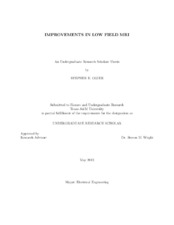| dc.description.abstract | The world of clinical magnetic resonance imaging (MRI) is presently dominated by multi-million dollar machines that use large superconducting magnets to generate very high quality images. It is possible to perform MRI at lower magnetic field strengths, which allows the use of lower-cost permanent or resistive magnets. Unfortunately, working at lower field strengths comes at a cost, as the intensity of the magnetic resonance signal is much lower at low magnetic fields. Although low fields were common in the early days of MRI, they have since become displaced by scanners with much higher field strengths. Today, advances in MRI such as prepolarized and hyperpolarized imaging are making low field strengths attractive once again,
This research presents work devoted to three problems in low-field MRI. The first development is in the use of non-phase stable receivers. Phase stability in an MR receiver is necessary if phase-encoded imaging, the industry standard, is to be used. Our lab had previously developed a desktop MRI system, but the receiver was not phase stable. By digitizing the second RF pulse in the pulse sequence, it is possible to extract information about system delays to correct for phase shifts, rendering the system phase stable.
A second effort is the development of a simple single-axis gradient set to better allow slice selection. Although many gradient sets similar to this have been developed, this set is somewhat unique in that it was designed and constructed specifically for this system, which has a static magnetic field in an unconventional direction. The stronger gradient allows for the selection of thin slices with RF pulses of reasonable length.
The third effort was in low-noise RF coils. Typical MRI systems are enclosed in conductive rooms or cages to shield them from external noise sources. By developing an RF coil that rejects external noise, it would be possible to greatly reduce the size and cost of low-field MRI systems by the need for RF screening. We were able to acquire images successfully without the use of an RF shield using an RF gradiometer coil, which uses two loops to reject noise from sources outside the sample.
In addition, an investigation was made into moving the desktop MRI system into the fringe field of a large superconducting magnet. This was an attractive possibility because it is possible to find a point in the fringe field of the superconducting magnet which is the same strength as the permanent magnet used for the other experiments (.06T). Although this experiment was unsuccessful in producing a detectable spin echo, a great deal of knowledge about the limitations and difficulties of fringe-field MRI was gained in the process. | en |


